Black Eyed Peas And Rice Recipe
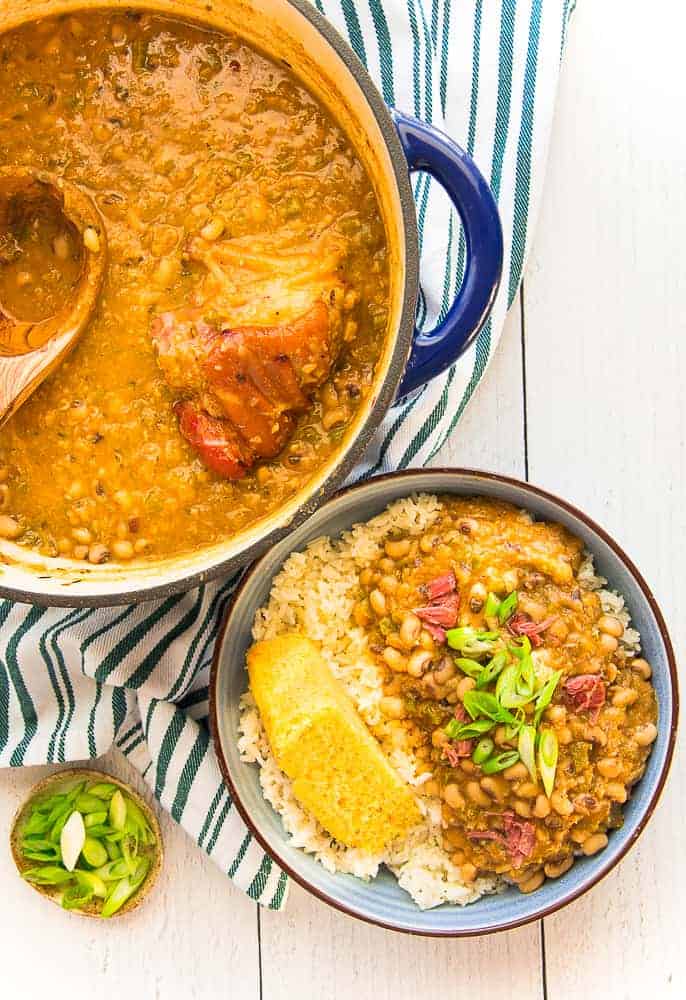
I'm participating in the 2021 Black History Virtual Potluck. A collaborative menu of recipes contributed by 40+black bloggers from around the globe in honor of Black History Month. See a sampling of some of the amazing participant recipes down below. I grew up eating Black Eyed Peas and white rice every year on New Year's Day. Mind you, they weren't good black-eyed peas (BEP), but that didn't stop us from having to eat them. In the Black culture (and probably in the collective South) BEP are eaten to usher in wealth and prosperity in the coming year. I didn't care about all that and I grew to hate them.
I wasn't a child of the "Just try it to see if you like it" era. My parent's mantra was, "You eat what I feed you, and that's that." As a result of how gross theirs were, I grew up thinking black-eyed peas were the devil. They didn't have any flavor, they were always too hard, and I just associated them with the lousy childhood home I grew up in. If anyone ever tells you food isn't a powerful memory, they're lying, BEP are proof of that for me.

My culture is very important to me, though. So much so, I willingly ventured down that bad memory lane to create a new, tastier version of black-eyed peas. I was on a mission to reintroduce myself (and introduce Hector and the twins) to the Southern and African American tradition of eating the peas for the New Year and most certainly in honor of Black History Month.
What are Black Eye Peas?
Black eye(d) peas are a legume often referred to as cowpeas, though they are actually a subspecies of the cowpea. Some folks call them black eyed, black eye, or blackeye peas. I'm in the first camp. Tons of cultures worldwide consume this small, kidney-shaped bean, identifiable by the prominent black spot (or eye) found in its center.
Black-eyed peas have a muted, earthy flavor when eaten as is. They are very nutritious, too. The great George Washington Carver once encouraged farmers to sow the peas in their fields to replenish lost nutrients and provide a crop for them to consume high in calcium, protein, and fiber.
Where do they originate?
In my research, I could not track down a specific country of origin for the black-eyed pea. As I mentioned before, many countries include it in their diets.
Africans and Brazilians form a patty after mashing them, then fry those in dendê, or palm oil, or similar frying oil. Mediterranean and Middle Eastern cuisines serve them chilled in a light lemon vinaigrette. Asians, specifically Indians, simmer the peas in a spiced coconut curry sauce.
There are many recipes are highlighting the funky-looking bean nowadays. Texas caviar features the pea in its preparation. I've seen countless salads and stews incorporating them as well. But here in the States, the most popular way to prepare black-eyed peas is like this.
Isn't this called Hoppin' John?
Now, you might be used to referring to this recipe as hoppin' John, but, as Amethyst Ganaway informs us in this Serious Eats article , historically, hoppin' John has an altogether different makeup and pea.
Instead of being made with black-eyed peas, hoppin' John was made with field peas that are reddish-brown in color. And unlike our method of spooning the peas on a bed of white rice, the OG hoppin' john was a mashup of rice and peas cooked together in one pot.
Amethyst explains that the black-eyed peas and rice dish was the result of The Great Migration. Though Black Americans couldn't bring their ingredients, they didn't fail to tailor the foods they found in their new cities to their beloved dishes from back home.
How do I prepare dried Black Eyed Peas for cooking?
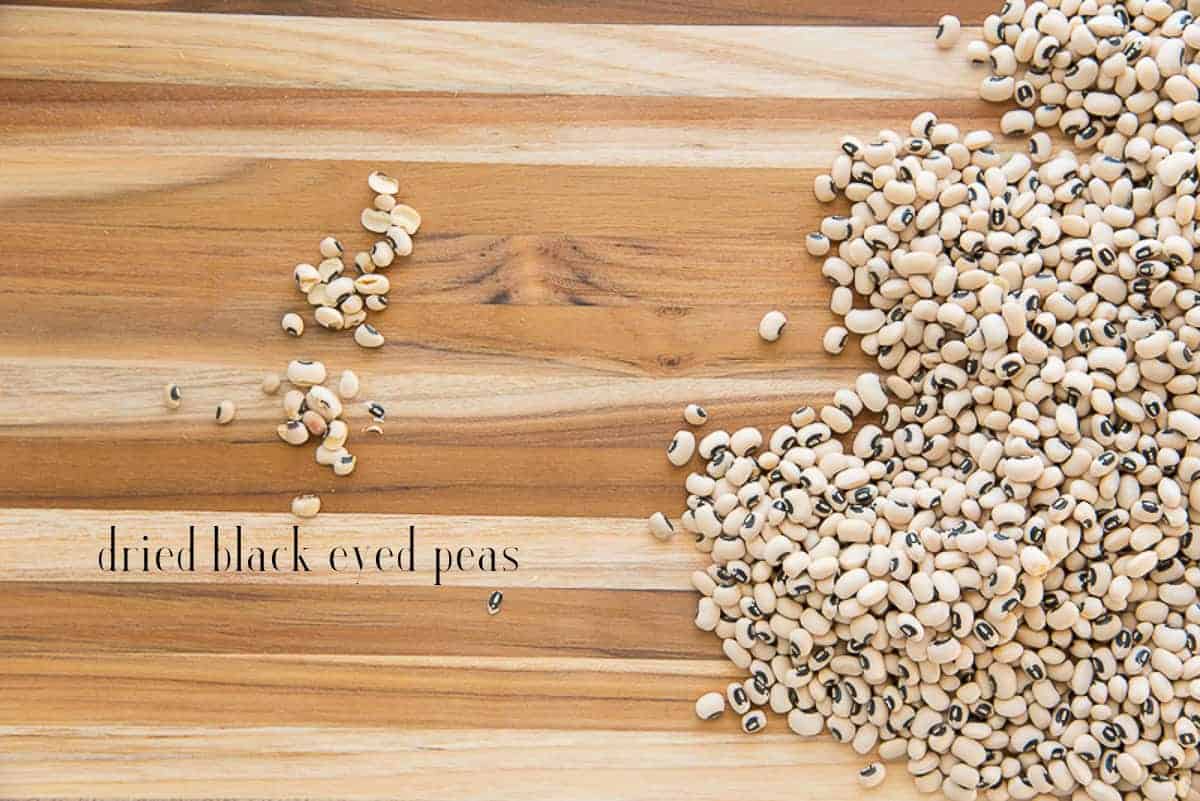
Before we get too far into preparing the peas, we need to sort them, and we should soak them.
Grab a one-pound bag of your preferred brand of dried black-eyed peas . This recipe makes a good amount of them if you like to eat them as a main course as we do. If not, you can easily adjust the measurements by half.
Once you have your peas, dump them out onto your countertop and sort them. Just pick through them and remove those that are split, misshapen, or minuscule. Also, get rid of stones or twigs that may have found their way into the bag during processing. Sort through the pile of peas once or twice more. Usually, I sort through any beans or legumes three times to be sure I'm cooking only the best. Discard any undesirables after sorting through them.
Next, rinse the chosen ones under cold, running water. Dump them into a dutch oven and cover them with at least 6-inches of cold water. Soak the peas for 8-12 hours (or overnight).
Do I have to soak them?
Dried legumes don't have to be soaked for an extended period before cooking them, no. Did my Mom and Abuela tell me they should be? Yes. According to the fickle culinary powers that be, however, centuries of Hispanic and African cooks are wrong. According to those who don't eat beans nearly as much as most of the cultures mentioned above, you can just simmer the beans and end up with the same results.
One thing you should know about me, though, is: if it ain't broke, I ain't fixing it. I would rather throw my beans into a bowl and soak them while I'm working or sleeping than stand over the stove, stirring simmering beans for hours. That said, you can most certainly simmer away from dried to tender, or you can opt to do a quick-soak method.
For the quick-soak method: bring the peas up to a boil after rinsing them. Turn off the heat, cover the pot of peas, and allow them to sit in hot water for 1 hour. Drain them as use as you feel led to. The new fandangled method is to add the beans to boiling water and cook them per recipe instructions. While I have tried the quick soak method and the results to be acceptable, I'm not going to entertain the latter method. My ancestors would twirl in their graves.
Can I soak my Black Eyed Peas ahead of time?
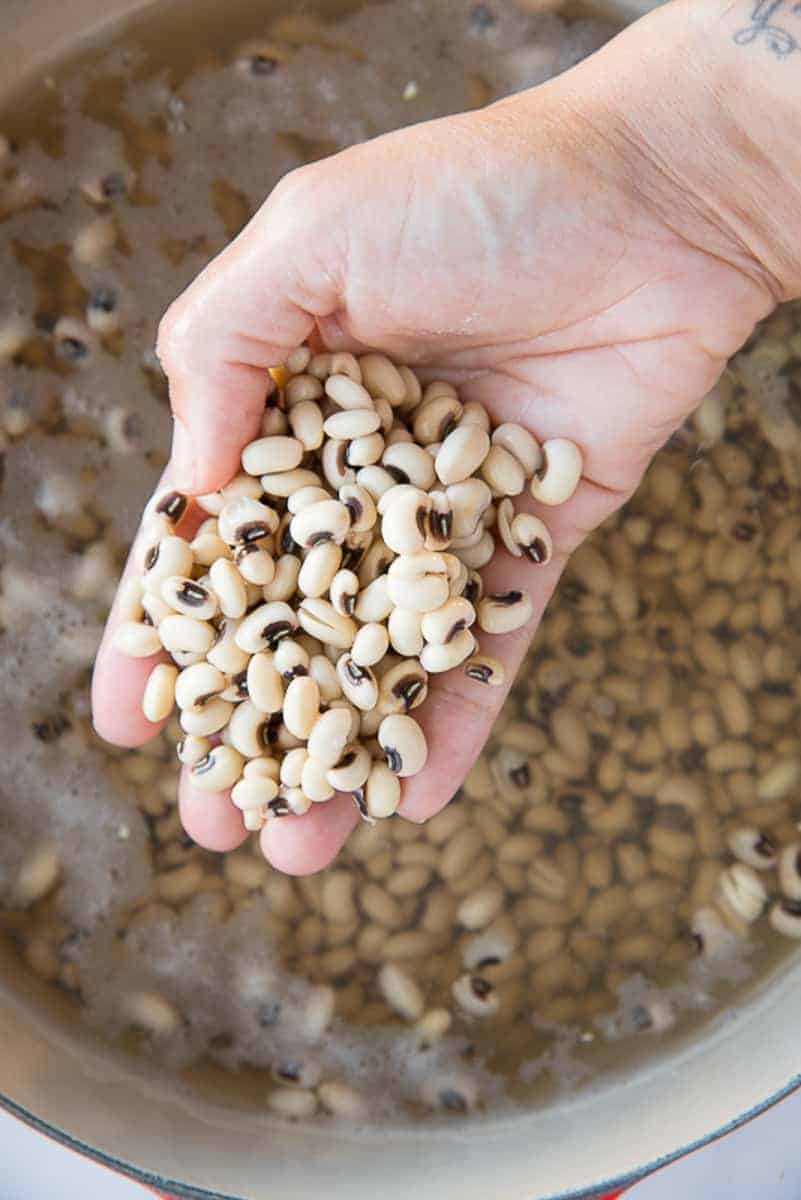
Though I do recommend at least the quick-soak method, there's a way you can cut down on same day prep. After covering the peas with water, place them (still in their dutch oven) in the fridge for 2 days. After 24 hours, I usually pour off the soaking water to keep it from tasting off, but this isn't a must.
Do be sure to cook the beans within 2 days of soaking. Alternatively, drain the peas and transfer them to a freezer storage bag. Freeze them for 3-4 months.
Do I get rid of the cooking liquid?
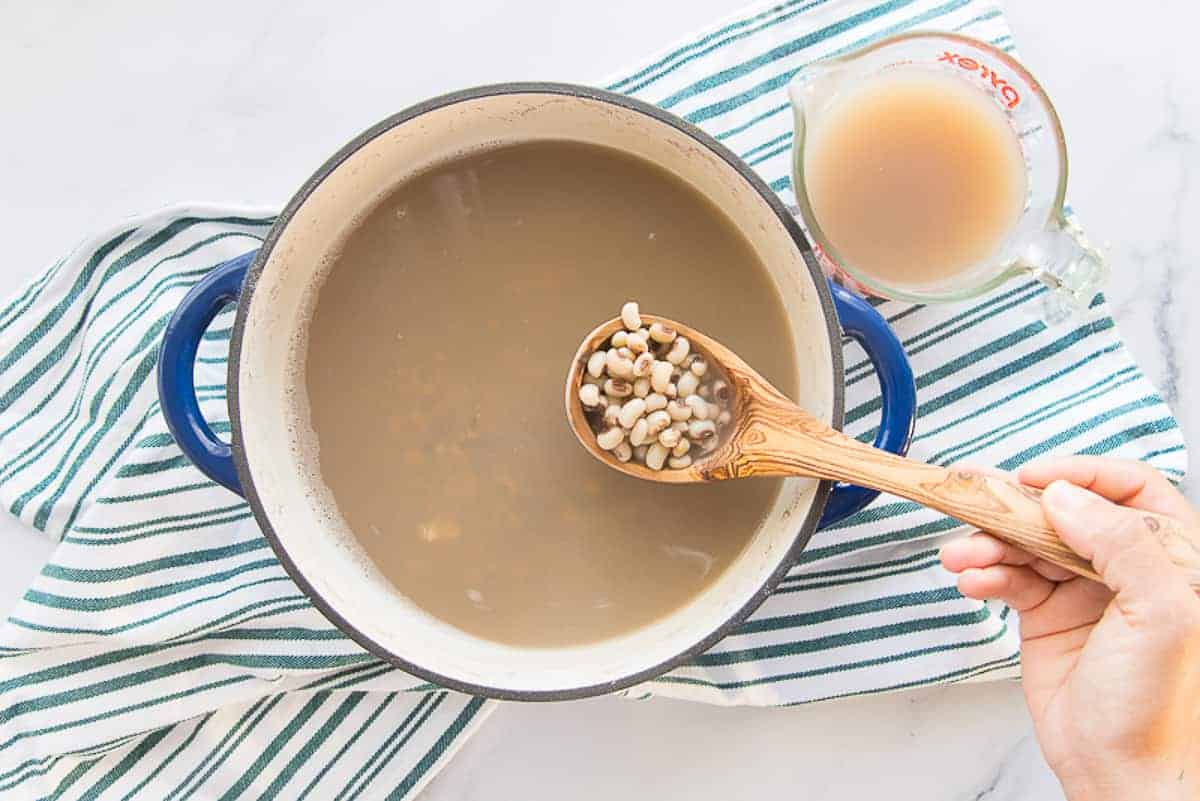
Once the peas have soaked, drain off the soaking water. Give them a quick rinse under cold water before returning them to the dutch oven. Add cold water to the pot, then bring the water up to a gentle simmer over medium-low heat. Gently simmer the peas for 20 minutes. Try to avoid boiling the peas, as that will likely cause them to split considerably later on.
After simmering the peas, remove 2 cups of the cooking liquid from the pot. While most cooks prefer to discard all of the cooking liquid, I like to use it to give my finished dish more flavor and texture. Once you've reserved the bean liquid, drain the rest of the liquid away and rinse the peas again in cold water. This stops the cooking process and gets rid of excess starch from the bean's exterior.
The black-eyed peas are now ready to cook!
Do I have to use dried Black Eyed Peas?
While I highly recommend using dried black-eyed peas, you can substitute canned in this recipe since, sometimes, they're more convenient.
If you prefer to use canned peas, you need to replace the dried variety with the same amount of canned. Be sure to drain off the liquid in the can of peas, though. That liquid has more salt in it than our cooking liquid would from the dried peas. Once you drain the liquid, give the peas a rinse under cold running water and use them as follows.
How do I flavor Black Eyed Peas?
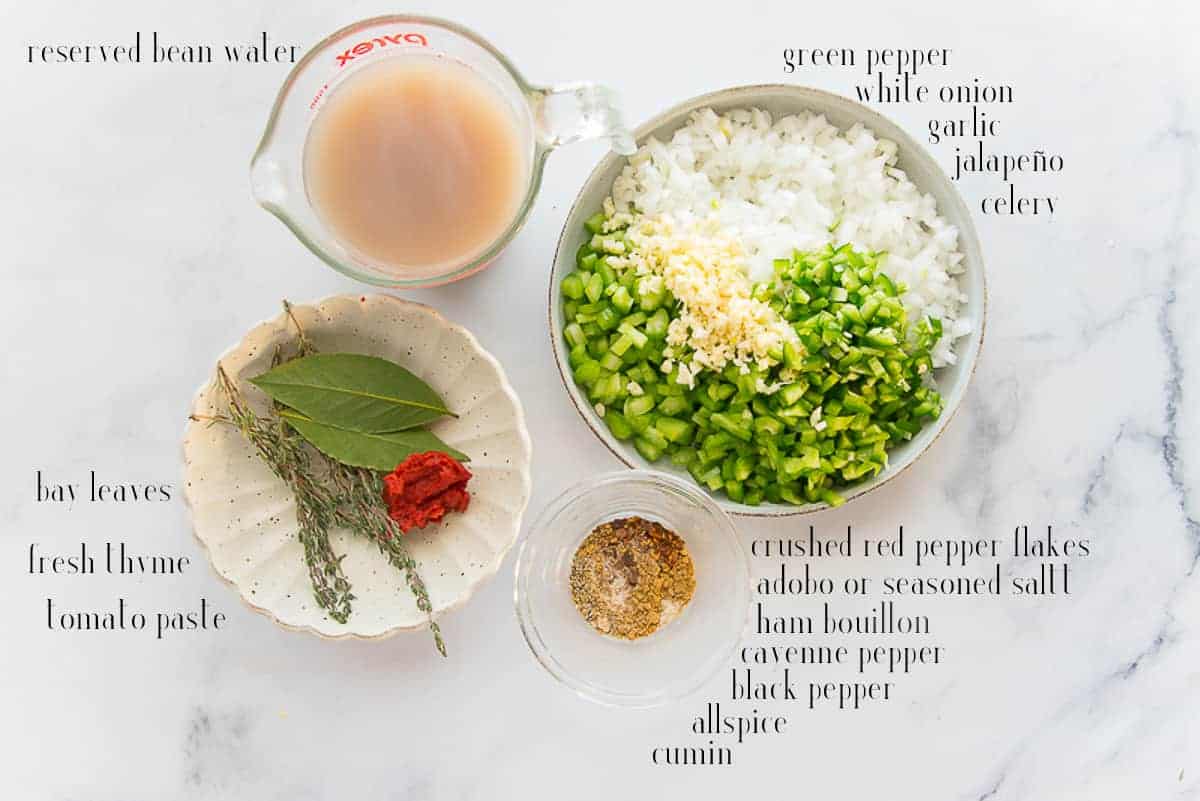
You know I'm big on flavor, and these peas are no exception. I don't season the liquid I soften the peas in because I plan to reserve all of that for the broth I'm going to serve the peas with.
In addition to the liquid you reserved from softening the peas, you need the holy- with a little "h"- trinity! Additionally, garlic, jalapeño (this is optional), fresh thyme and bay leaves, tomato paste, and a mix of spices round out the seasonings. Lastly, a ham hock and ham bouillon provide more savory deliciousness than we deserve.
What is the trinity?
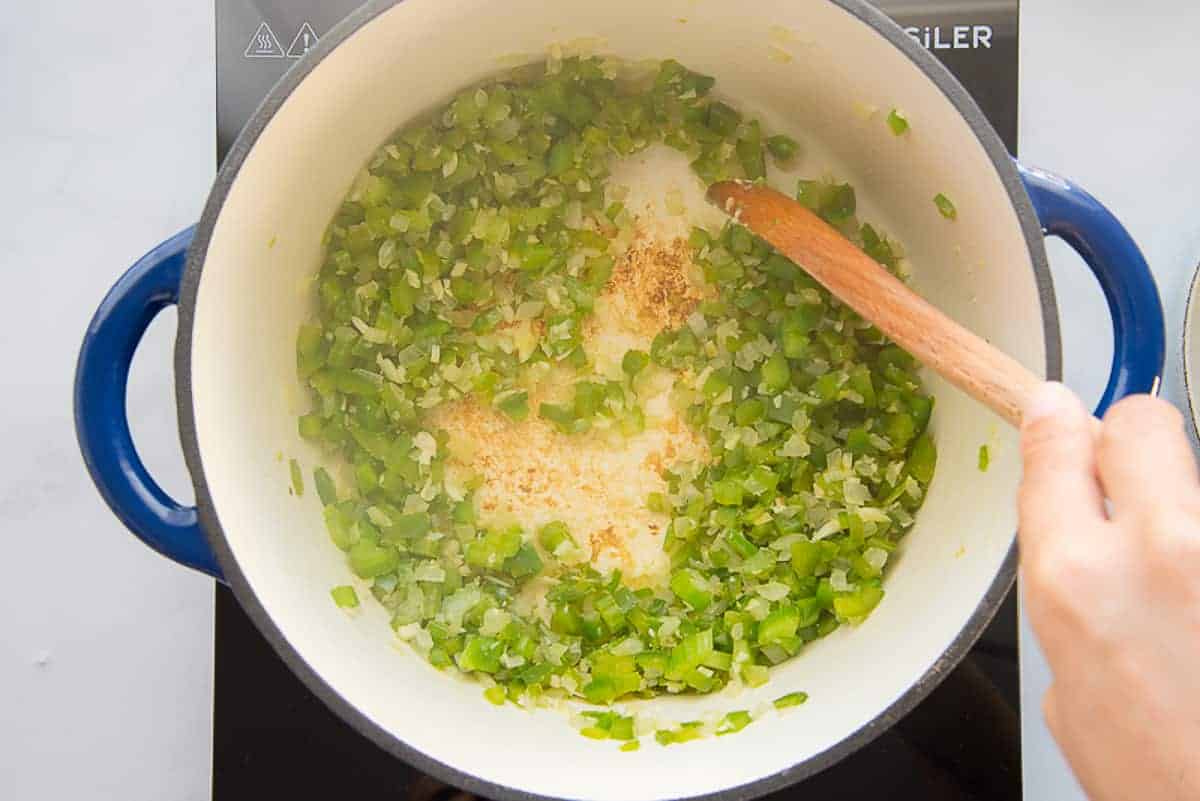
In Cajun and Louisiana cooking, the holy trinity is a flavoring base comprised of onion, green bell pepper, and celery. While this isn't a Louisianan recipe per se, I see no reason to leave out this pillar of culinary magnificence. I'm going a step farther with the garlic and jalapeño, which I like to add for a kick.
Heat a small amount of cooking oil in a dutch oven over medium heat. Add the holy trinity, the garlic, and the jalapeño pepper to the shimmering oil and sauté them for 2 minutes. Once the onions and peppers appear glossy, lower the temperature to medium-low and continue sautéing the mixture for 13 more minutes.
The goal here is to cook the aromatics down almost to a pulp without caramelizing or burning them. If the bottom of your pot gets darker than what you see above, reduce the temperature. You need to cook it for the full 15 minutes, so adjust the heat accordingly.
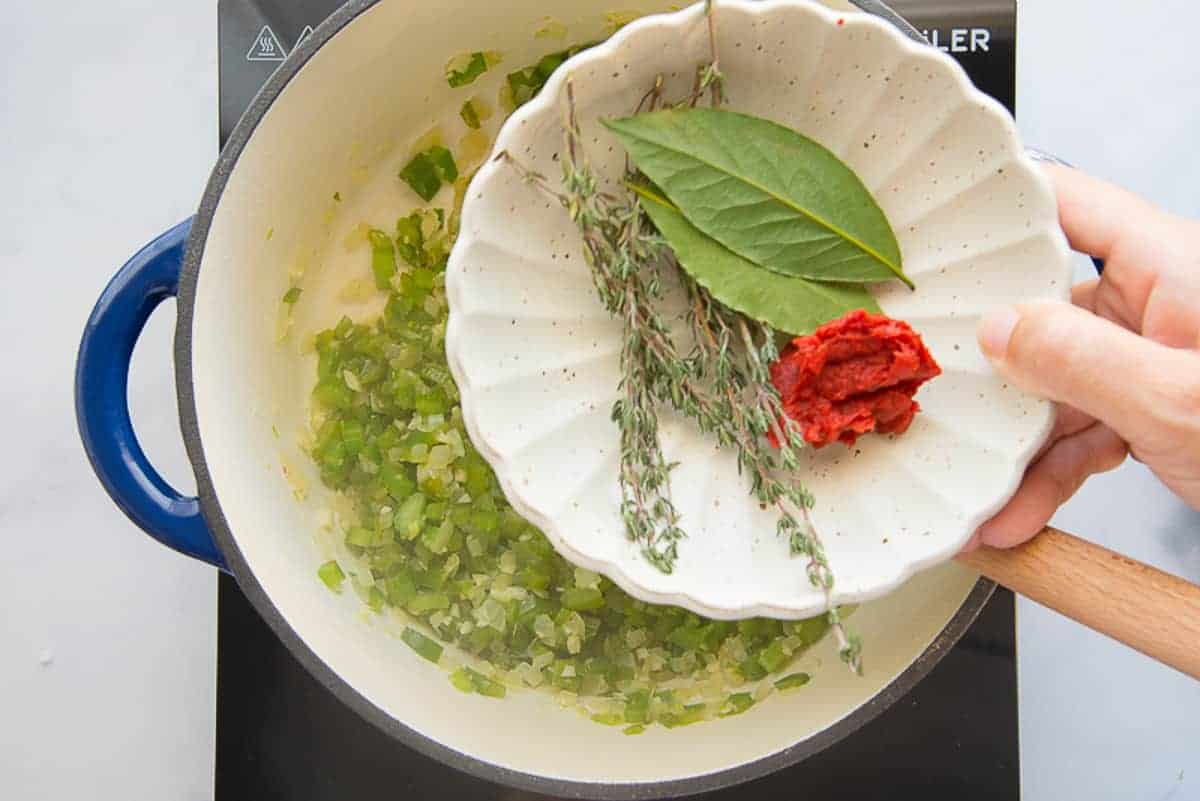
After 15 minutes, stir in the fresh herbs, tomato paste, and all of the spices. Stir these into the sautéed veggies until a thick paste forms, or for 1-2 minutes.
Do I have to use ham to flavor my Black Eyed Peas?
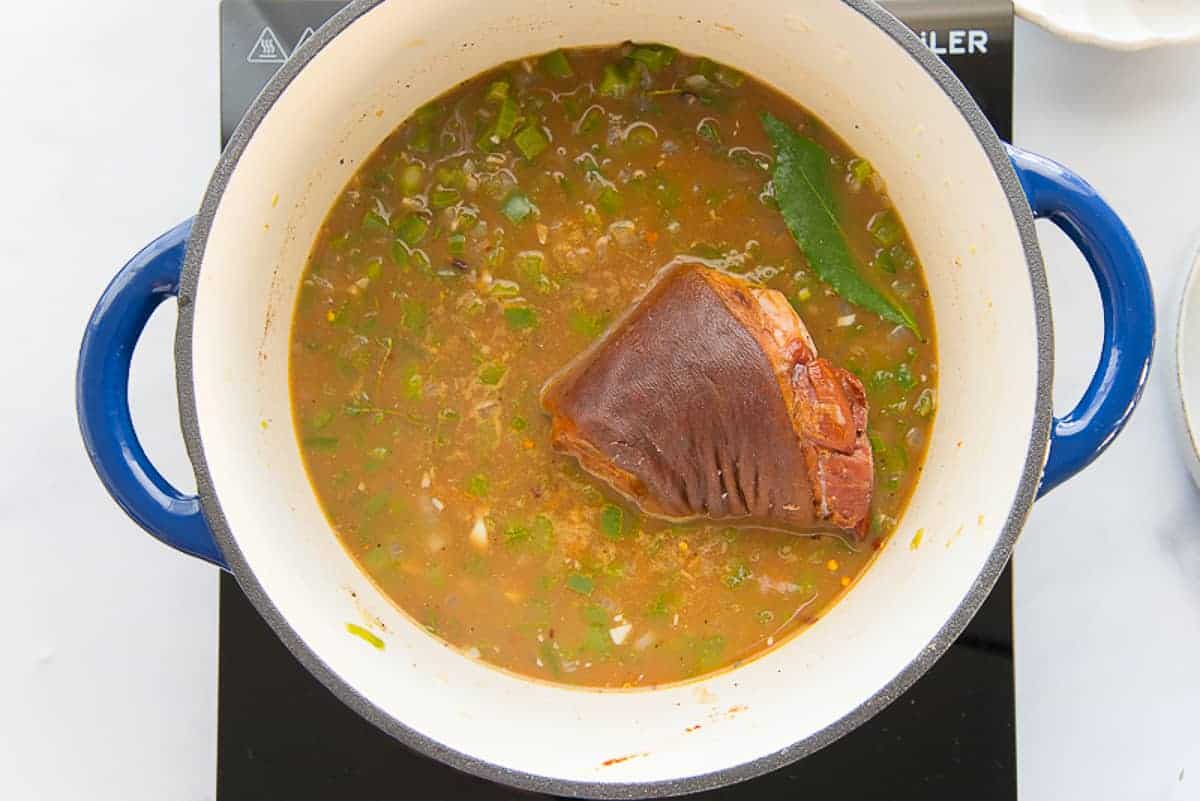
Next, pour in cold water, the reserved cooking liquid; then add the ham bouillon and the ham hock to the pot. Increase the heat to medium.
If you don't eat pork, feel free to swap out the ham hock for a smoked turkey wing (or neck) and the ham bouillon for chicken. Turkey accomplishes the same goal of flavoring our black-eyed peas.
Bring the liquid up to a gentle boil. As you stir, be sure to scrape the bottom of the pot to lift any stuck-on bits of food.
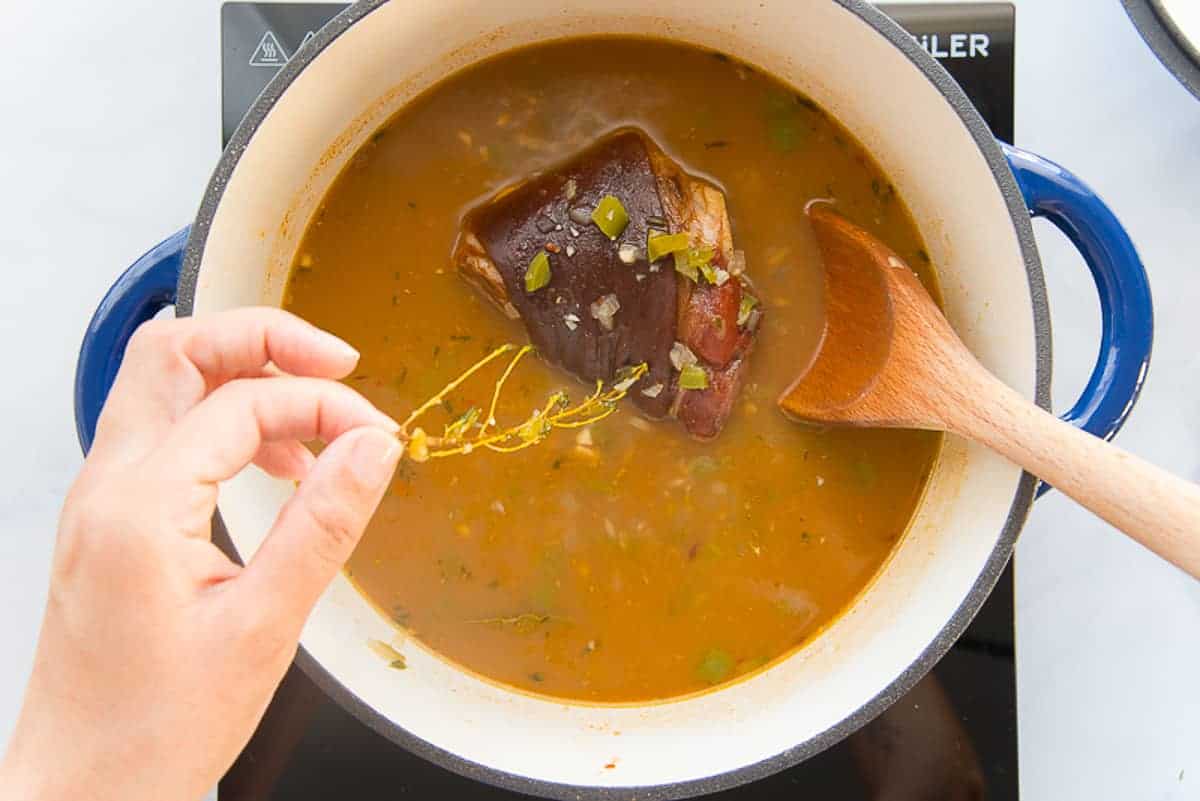
Once the liquid comes to a boil, reduce the heat to medium-low once again and cover the pot. Simmer the liquid for 10 minutes. This concentrates all of those flavors in the liquid, which we'll later cook our black-eyed peas in.
After 10 minutes of simmering, fish out the bare stems of thyme. The thyme stems are easier to locate and remove now. Leave the bay leaves in as we're going to use them as long as possible.
How long do I simmer the peas?
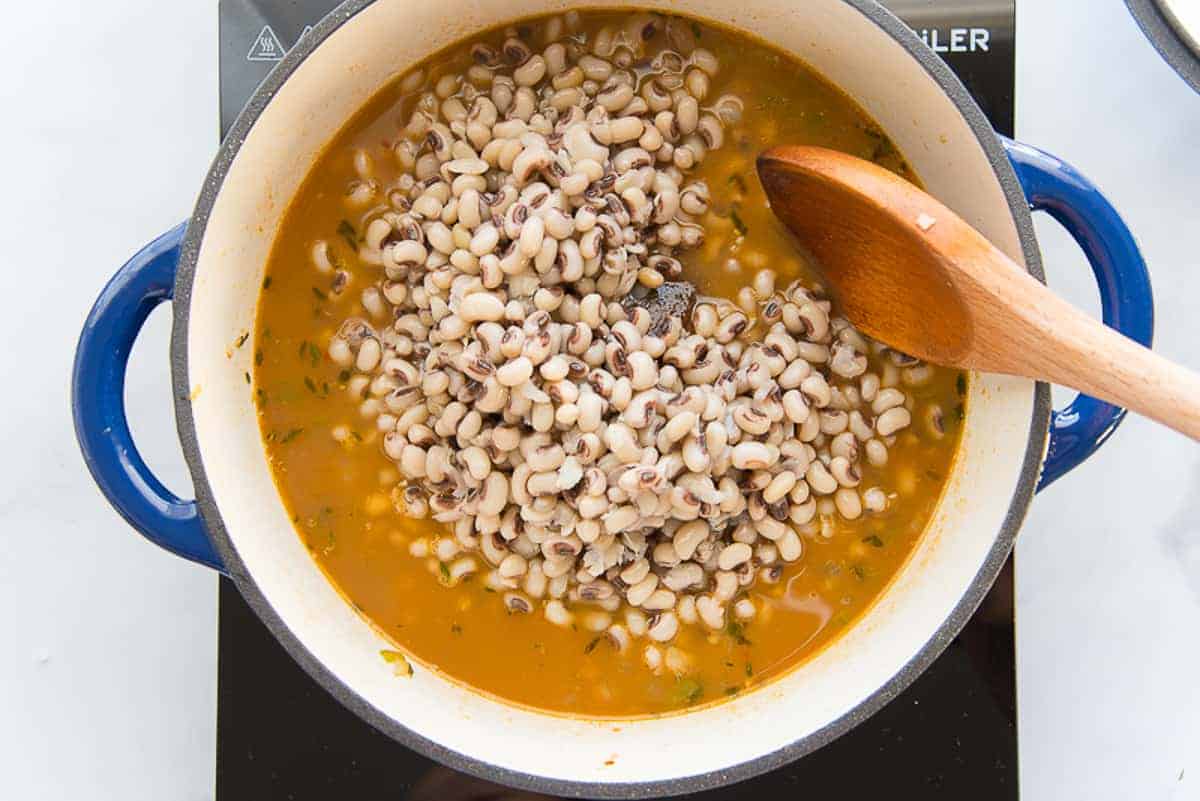 Stir the softened black-eyed peas into the flavorful ham (or turkey) broth you created.
Stir the softened black-eyed peas into the flavorful ham (or turkey) broth you created.
Bring the liquid up to a gentle simmer. Avoid boiling the peas as that will cause a lot of them to split. While a gentle bubbling is okay, minimal movement on the surface of the liquid is even better. Once the liquid comes to the correct temperature, cover the pot.
Gently cook the peas for 20 minutes, stirring them every so often to keep them from sticking to the bottom of the pot.
How can I make the sauce thicker?
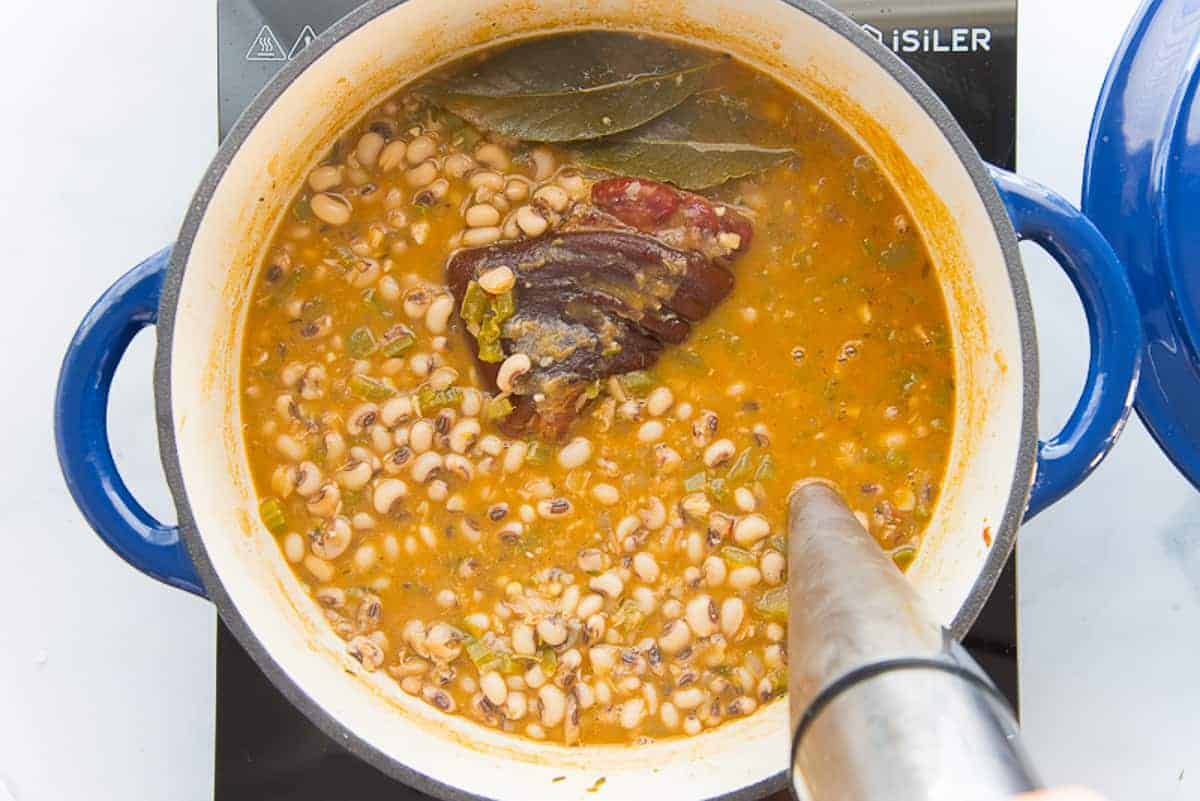
After 20 minutes of gentle cooking, taste a pea or two. The peas should have slight texture to them but shouldn't be hard or crunchy. If they are, continue simmering them for another 10-15 minutes.
While the peas can be served as is, I prefer a slightly thick sauce for my black-eyed peas. If you do as well, use an immersion blender to blend just a small amount of the peas in the pot. I eyeball a quadrant of the pot and blend just that amount with my immersion blender.
If you prefer a thinner broth for your peas, you can just skip the blending altogether. Taste the broth with a couple of peas and adjust the seasonings to taste by adding a little more adobo or seasoned salt.
What are some other beans I can prepare with this method?
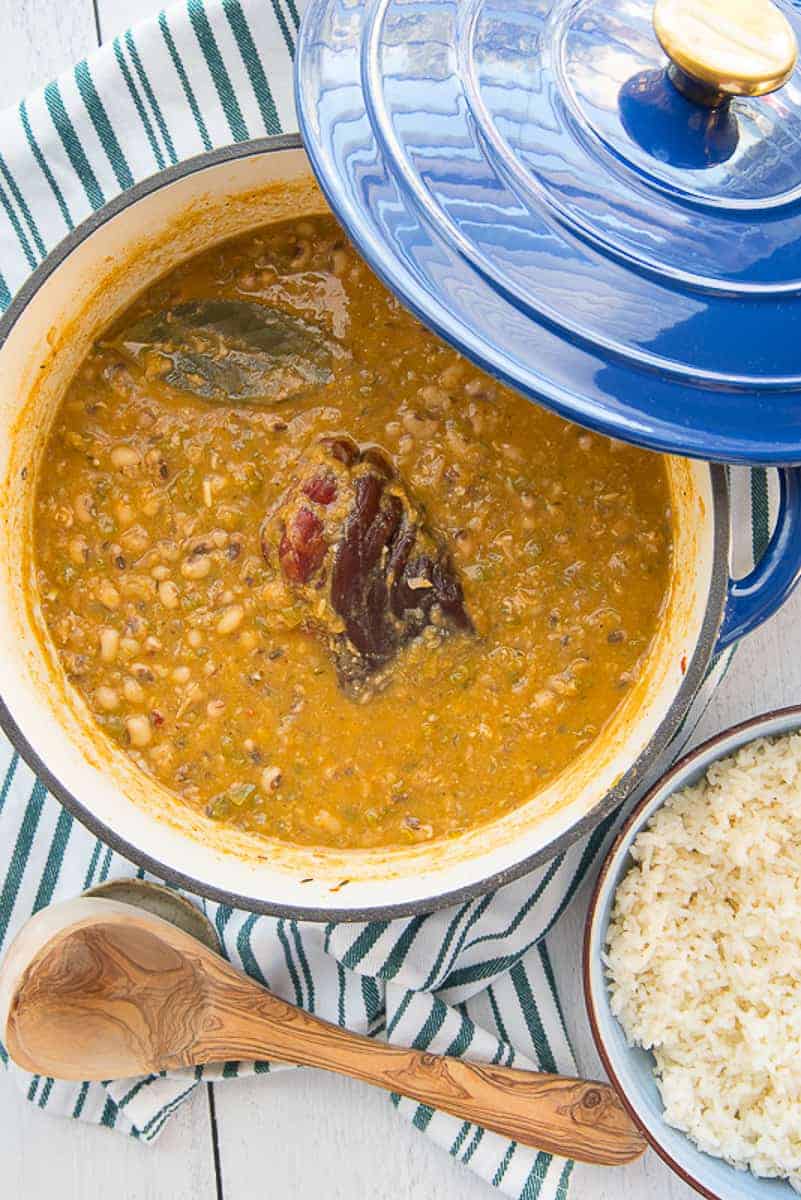
Except for lentils, all dry beans can be prepared using this method.
If you prefer more Hispanic flavors, check out my Habichuelas Guisadas recipe.
What do I serve Black Eyed Peas with?
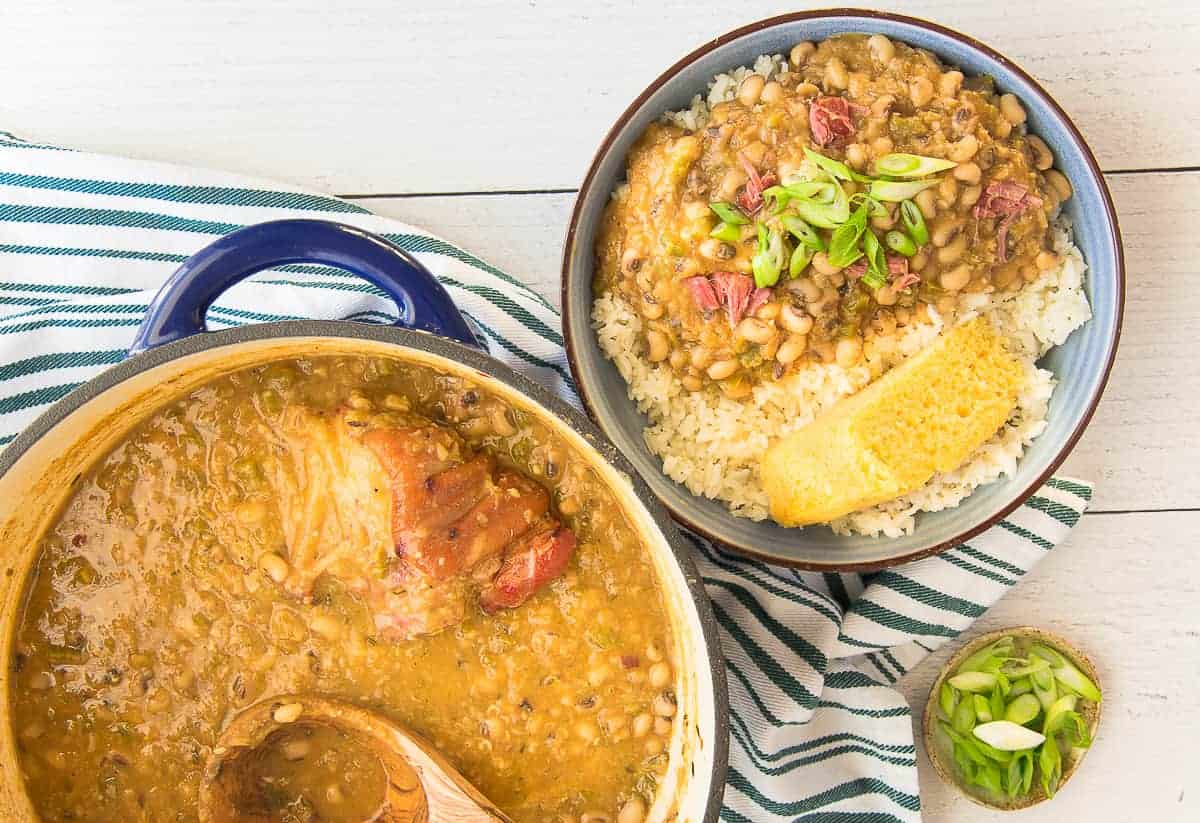
The traditional way to serve these black-eyed peas is spooned over Steamed White Rice and alongside a generous slice of cornbread.
I serve the dish as a main course after cutting the meat from the hocks. Even without the ham hocks, the peas are substantial enough to serve as an entree.
You can skip the rice and bread too. They're that flavorful on their own.
How do I store leftovers?
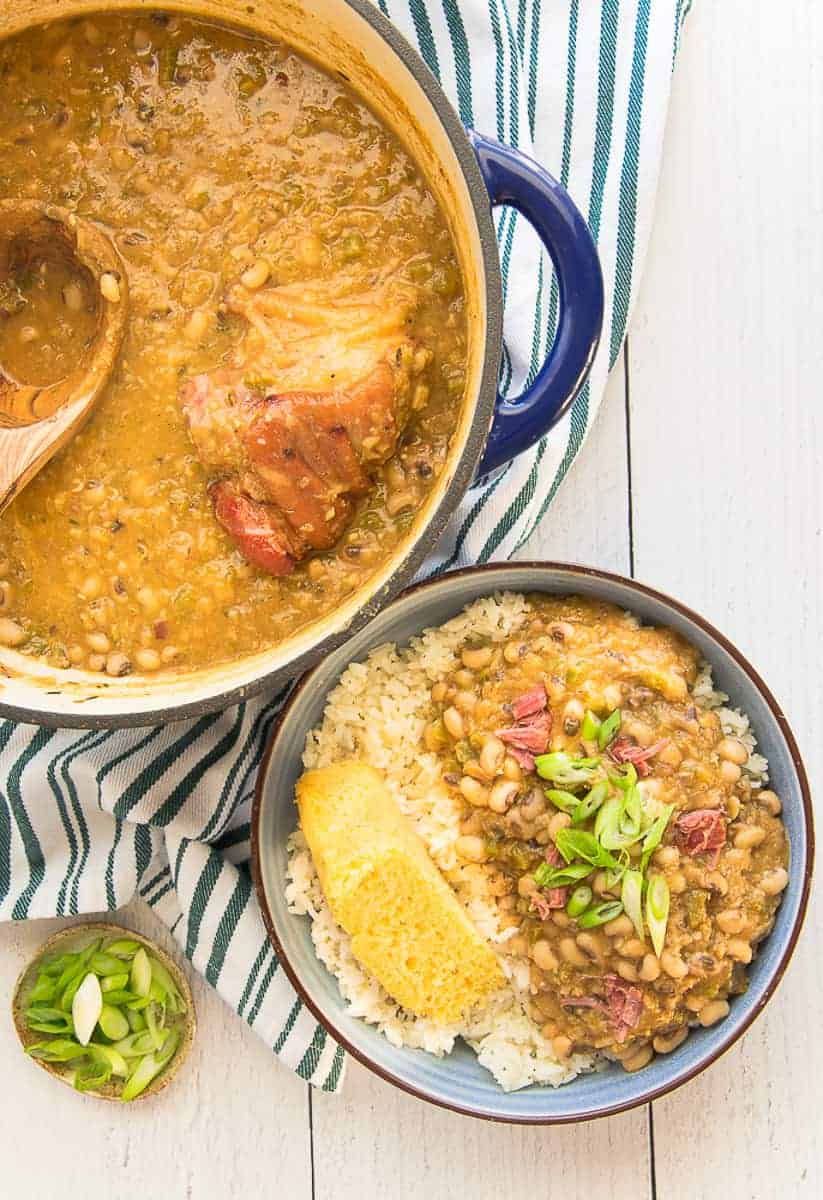
Wait until the black-eyed peas are entirely cool. Transfer them to a food storage container and store them in the fridge.
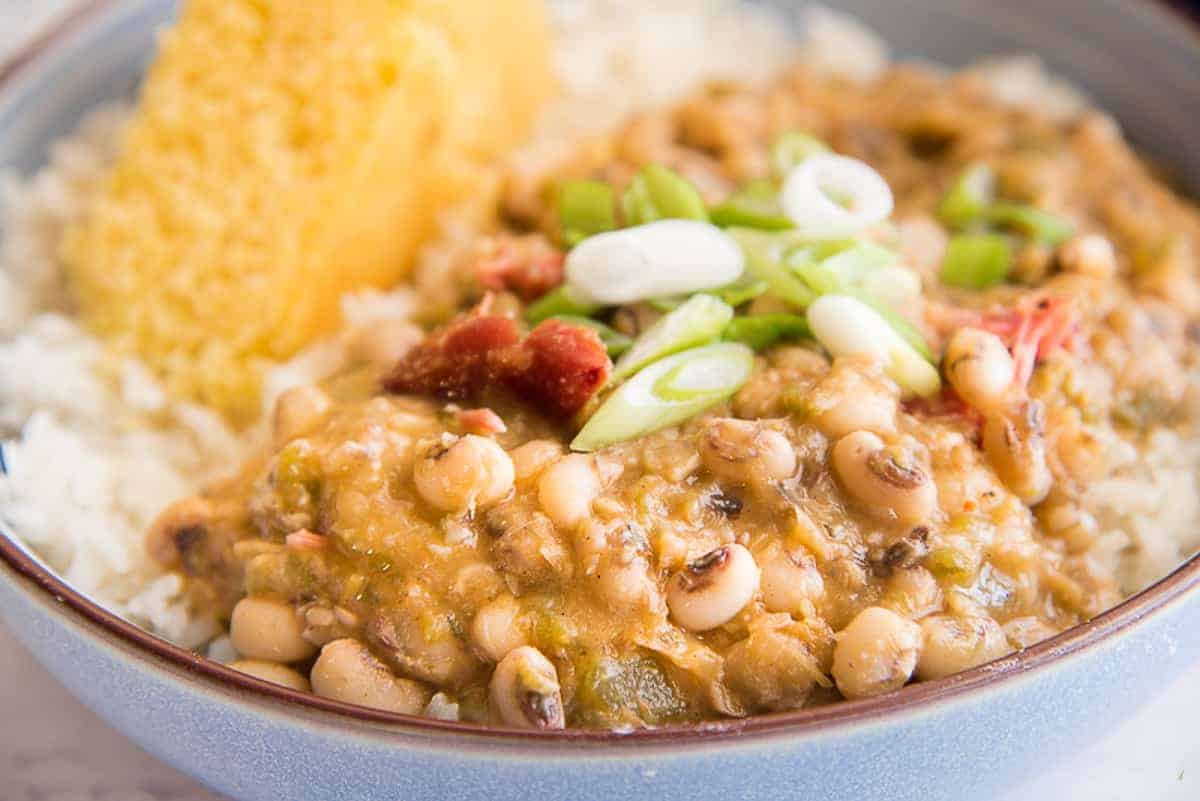
Leftover black-eyed peas keep, in the fridge, for 3 days. Leftovers never last that long in our house. I'm sure they'll keep for 5 days, but food safety rules say only 72 hours for leftovers.
Can I freeze the cooked Black Eyed Peas?
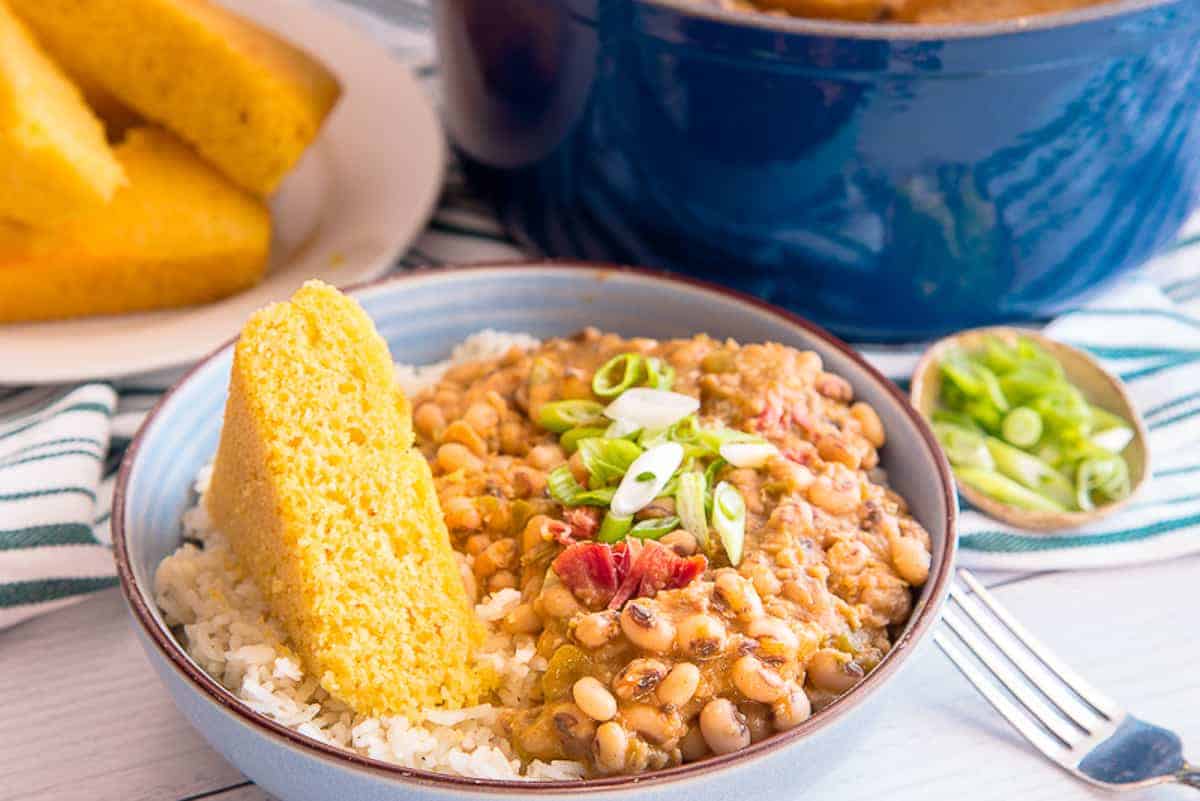
Freeze the black eyed peas after cooling completely. Transfer the peas to a freezer storage bag and freeze them for up to 4 months.
Thaw the peas in the fridge and reheat them in the microwave or on the stove top with a small amount of broth or water stirred in.
As we approach the new year and celebrate all of the accomplishments and advancements African Americans have contributed to our nation, I do hope you cultivate new, or reinvigorate old, traditions with your family. My family and I wish you the happiest and healthiest in the future. Be sure to pin and share this recipe so your friends and family can, hopefully, usher in wealth and prosperity too! And take a look at some of my friend's great recipes below:
Smoky Sweet Potato and Tahini Stew | Supper With Michelle
Authentic Misir Wot | Ethiopian Red Lentil Stew | That Green Lyfe
The Lamin Rice (Afro-Fusion Jollof Rice) | The Food Disciple
Sweet Potato & Coconut Cinnamon Rolls | Vee the Baker
Oven-Baked BBQ Ribs | Whisper of Yum
Passionfruit Coconut Layer Cake | A Classic Twist
Shrimp and Cauliflower Grits | A Girl Called Adri
Malawah (Somali Sweet Pancake) | A Sweet Point Of View
Spicy Okra & Corn Salsa | Beautiful Eats & Things
Peanut Curry Braised Ribs | Britney Breaks Bread
Black Eyed Peas with Rice
Begin soaking the black eyed peas the evening before you plan to cook them. Prep time includes an 8 hour soak.
Course Main Course, Side Dish
Cuisine North American
Keyword beans and legumes, black eyed peas
Prep Time 15 minutes
Cook Time 50 minutes
Black Eyed Pea Prep 8 hours 20 minutes
Total Time 9 hours 25 minutes
Servings 12 as a side dish or 8 as a main course
Calories 184 kcal
-
4-quart dutch oven
To Soak the Black Eyed Peas (begin 8 hours ahead)
- 1 pound dried black eyed peas sorted and rinsed
- 6 cups cold water
To Cook the Black Eyed Peas
- 1 tablespoon lard or vegetable oil
- 1 cup (one small) white onion peeled and diced
- 1 cup (1 medium) green bell pepper seeded and diced
- 1/2 cup (2 stalks) celery trimmed and diced
- 2 tablespoons (1 medium) jalapeño pepper seeded and minced (optional)
- 1 tablespoon (6 cloves) garlic peeled and minced
- 2 large bay leaves
- 4 sprigs thyme
- 1 heaping tablespoon tomato paste
- 1 tablespoon adobo (or seasoned salt), plus more to taste
- 2 teaspoons ground cumin
- 1/2 teaspoon black pepper
- 1/4 teaspoon ground allspice
- 1/4 teaspoon cayenne pepper optional
- 2 cups cold water
- 1 large ham hock or smoked turkey wing
- 1 ham bouillon crumbled (or chicken)
Soak and Soften the Black Eyed Peas
-
Place the sorted and rinsed black eyed peas into the dutch oven and cover them with the cold water.
Soak the peas on the countertop for 8-12 hours (or overnight).
-
Once the peas have soaked, drain off the soaking water.
Give them a quick rinse under cold water before returning them to the dutch oven.
-
Add 6 cups of cold water to the pot, then bring the water up to a gentle simmer over medium-low heat.
Gently simmer the peas for 20 minutes. To prevent excess splitting of the peas, don't allow the water to boil.
-
After simmering the peas, use a measuring cup or spoon to remove 2 cups of the cooking liquid from the pot.
Once you've removed the cooking liquid, drain the rest away, then rinse the peas again in cold water to stop the cooking process and remove excess starch from the bean's exterior.
Cook the Black Eyed Peas
-
In a dutch oven over medium heat, heat the lard until it melts and begins to shimmer in the pot.
Add the onion, green bell pepper, celery, jalapeño pepper, and garlic to the pot and sauté them for 2 minutes.
-
Once the onions and peppers appear glossy, lower the temperature to medium-low and continue sautéing the mixture for 13 more minutes.
Cook the aromatics down to a pulp without allowing them to caramelize or burn them. If mixture on the bottom of your pot begins to turn dark brown, reduce the temperature and add a 1/4 cup of cold water to slow down the browning. The only color you want is a golden brown on the bottom of the pot.
This mixture needs to cook it for the full 15 minutes, so adjust the heat accordingly.
-
After 13 minutes, stir in the bay leaves, thyme, tomato paste, cumin, black pepper, allspice, and cayenne.
Stir these into the sautéed veggies and cook until a thick paste forms, or for 1-2 minutes.
-
Next, add the cold water, the reserved cooking liquid, ham and the ham bouillon to the pot.
Increase the heat to medium. Bring the liquid up to a gentle boil. Scrape the bottom of the pot with your spoon to lift any stuck-on bits of food.
Simmer, Then Thicken the Black Eyed Peas
-
Once the liquid comes to a boil, reduce the heat to medium-low once again and cover the pot.
Simmer the liquid for 10 minutes to concentrate all of the flavors in the liquid.
-
After 10 minutes of simmering, remove the thyme sprigs.
Gently stir the softened black-eyed peas into the pot.
-
Bring the liquid up to a gentle simmer. Avoid boiling the peas as that will cause a lot of them to split. Once the liquid comes to the correct temperature, cover the pot.
Cook the peas for 20 minutes, gently stirring them every so often to keep them from sticking to the bottom of the pot.
-
After 20 minutes of gentle cooking, taste for doneness.
The peas should have slight texture to them but shouldn't be hard or crunchy. If they are, continue simmering them for another 10-15 minutes.
-
To thicken the sauce, black-eyed peas use an immersion blender to blend just a small amount of the peas in the pot.
If you prefer a thinner broth for your peas, you can just skip the blending.
Once you have your preferred consistency, taste the broth with a couple of peas and adjust the seasonings to taste by adding a little more adobo or seasoned salt.
-
Remove the ham hock and bay leaves from the pot. Shred or cut the meat from the hock and return the meat to the pot. Discard the bone (or save to use in soup) and the leaves.
Serve the black-eyed peas spooned over Steamed White Rice and garnished with sliced green onions.
Quick Soak Method (for the black eyed peas):
- Add the peas to the dutch oven and cover them with the cold water.
- Bring the water to a boil over medium heat.
- Once the water begins to boil, turn off the heat, cover the pot of peas, and allow them to soak for 1 hour on the stovetop.
- Drain the peas and use accordingly.
To Slow Soak (or Freeze) Uncooked Peas or Beans:
- Cover the peas with water, then place the dutch oven in the refrigerator for 2 days.
- Change the soaking water every 24 hours.
- Be sure to cook the beans within 2 days of soaking.
- Alternatively, drain the soaked peas and transfer them to a freezer storage bag.
Freeze them for 3-4 months.
To Use Canned Black Eyed Peas:
- Replace the dried peas with 4 cans of black eyed peas.
- Drain the liquid from the can of peas, then give the peas a rinse under cold running water.
- Use as instructed adding 2 cups of water or stock to the recipe to compensate for the lack of reserved bean water.
To Store Leftover Black Eyed Peas:
- Cool the black-eyed peas completely.
- Transfer them to a food storage container and store them in the fridge for 3-5 days.
To Freeze Cooked Black Eyed Peas:
- Transfer the peas to a freezer storage bag and freeze them for up to 4 months.
- Thaw the peas in the refrigerator before reheating them in the microwave or on the stove top with a small amount of broth or water stirred in.
Calories: 184 kcal | Carbohydrates: 27 g | Protein: 13 g | Fat: 3 g | Saturated Fat: 1 g | Cholesterol: 12 mg | Sodium: 132 mg | Potassium: 574 mg | Fiber: 5 g | Sugar: 4 g | Vitamin A: 200 IU | Vitamin C: 22 mg | Calcium: 66 mg | Iron: 4 mg
Black Eyed Peas And Rice Recipe
Source: https://senseandedibility.com/black-eyed-peas/
Posted by: scottofirther73.blogspot.com

0 Response to "Black Eyed Peas And Rice Recipe"
Post a Comment